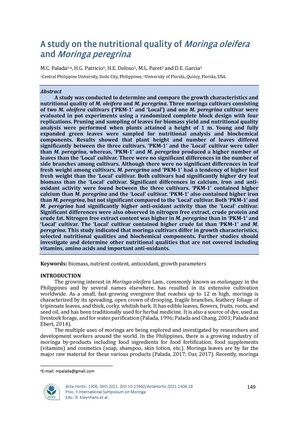A study on the nutritional quality of Moringa oleifera and Moringa peregrina

Request
Request a full text copyPage views
1,495Date
2021-04-15Share
Metadata
Show full item record
Abstract
A study was conducted to determine and compare the growth characteristics and nutritional quality of M. oleifera and M. peregrina. Three moringa cultivars consisting of two M. oleifera cultivars (‘PKM-1’ and ‘Local’) and one M. peregrina cultivar were evaluated in pot experiments using a randomized complete block design with four replications. Pruning and sampling of leaves for biomass yield and nutritional quality analysis were performed when plants attained a height of 1 m. Young and fully expanded green leaves were sampled for nutritional analysis and biochemical components. Results showed that plant height and number of leaves differed significantly between the three cultivars. ‘PKM-1’ and the ‘Local’ cultivar were taller than M. peregrina, whereas, ‘PKM-1’ and M. peregrina produced a higher number of leaves than the ‘Local’ cultivar. There were no significant differences in the number of side branches among cultivars. Although there were no significant differences in leaf fresh weight among cultivars, M. peregrina and ‘PKM-1’ had a tendency of higher leaf fresh weight than the ‘Local’ cultivar. Both cultivars had significantly higher dry leaf biomass than the ‘Local’ cultivar. Significant differences in calcium, iron and anti-oxidant activity were found between the three cultivars. ‘PKM-1’ contained higher calcium than M. peregrina and the ‘Local’ cultivar. ‘PKM-1’ also contained higher iron than M. peregrina, but not significant compared to the ‘Local’ cultivar. Both ‘PKM-1’ and M. peregrina had significantly higher anti-oxidant activity than the ‘Local’ cultivar. Significant differences were also observed in nitrogen free extract, crude protein and crude fat. Nitrogen free extract content was higher in M. peregrina than in ‘PKM-1’ and ‘Local’ cultivar. The ‘Local’ cultivar contained higher crude fat than ‘PKM-1’ and M. peregrina. This study indicated that moringa cultivars differ in growth characteristics, selected nutritional qualities and biochemical components. Further studies should investigate and determine other nutritional qualities that are not covered including vitamins, amino acids and important anti-oxidants.
Description
Conference paper
Suggested Citation
Palada, M.C., Patricio, H.G., Deloso, H.E., Paret, M.L. and Garcia, D.E. (2021). A study on the nutritional quality of Moringa oleifera and Moringa peregrina. In Kleynhans, R. , Laurie, S. M. , Chimuka, L. K. & du Toit, E. S. (Eds)., II International Symposium on Moringa (pp. 149-155). https://doi.org/10.17660/ActaHortic.2021.1306.18
Type
Conference paperISSN
0567-7572; 2406-6168ISBN
978-94-62613-05-8Subject(s)
Keywords
Series
ISHS Acta Horticulturae;1306Collections
- Conference papers [17]
Related items
Showing items related by title, author, creator and subject.
-
Evaluation of the efficacy of essential oil from moringa leaves (Moringa oleifera) against Staphylococcus epidermidis
Mañosa, Rhegil Joseph B. (2024-04)Staphylococcus epidermidis is a coagulase-negative and gram-positive bacterium that can cause arthritis, tendinitis, tenosynovitis, osteomyelitis and omphalitis in poultry animals. It is the most common cause of nosocomial ... -
Brooding performance of Philippine native chicken supplemented with moringa (Moringa oleifera Lam.) and hot red pepper (Capsicum annum L.) as mineral and vitamin premix
Servidad, Layka A. (2019-04)The study was conducted from February 21 to March 14, 2018 at CPU-CARES Research and Development Learning Center, Jaro, Iloilo City. The study was conducted to determine the brooding performance of Philippine native chicken ... -
Acceptability of oregano (Origanum vulgare) and moringa (Moringa oleifera) cookies
Granada, Maynel N.; Amalia, Sharyne A.; Canitan, Erna Lynne C.; Colesio, Hyacinth Jade D.; Padernilla, Rea Kieth N. (Central Philippine University, 2022-05)Moringa (Moringa oleifera) and oregano (origanum vulgare) cookies have gained popularity and conquered food markets due to increased awareness of health benefits from polyphenols. Oregano (Oreganum vulgare) and moringa ...






